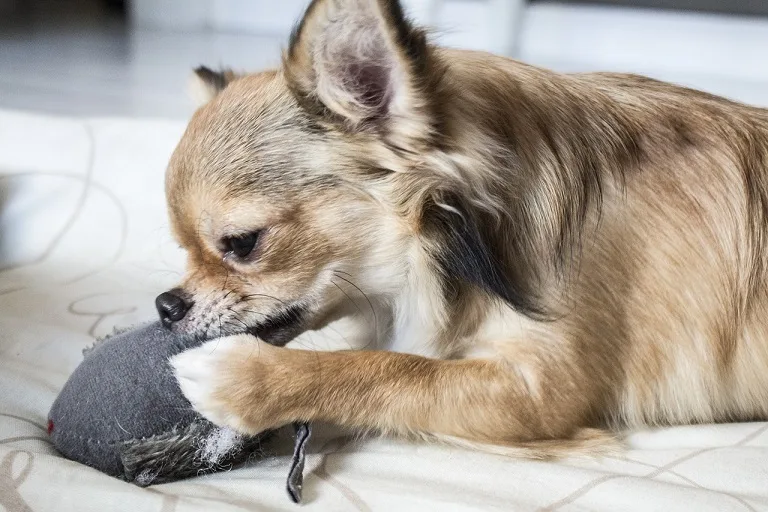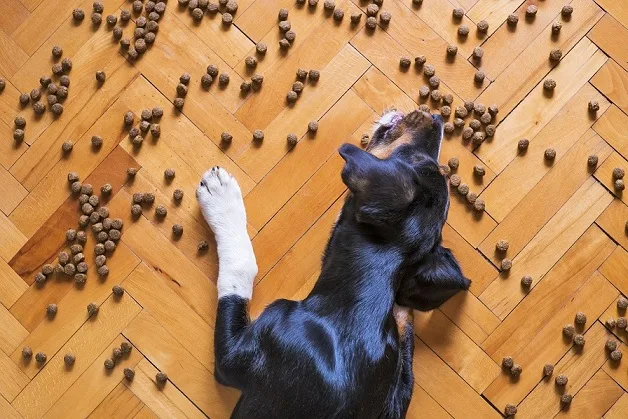Dog Separation Anxiety Symptoms: Introduction
Dogs are renowned for their devotion, amusement, and company. Dogs are often described as individual best friends. Dog separation anxiety is considered the most typical type of anxiety. Dogs can display a variety of behaviors that are a clear indication of separation anxiety when left alone. Therefore, In order to provide their canine companions with the assistance they require, dog owners must be aware of the symptoms of separation anxiety.
What is Dog separation anxiety?
Dogs with separation anxiety go through tension and worry when they are removed from their owners or left alone. Numerous undesirable behaviors and symptoms in dogs might result from this. Separation anxiety is an emotional reaction to being left alone and is not a behavioral issue.
Moreover, it is a behavioral problem that affects a lot of dogs and can lead to vocalizations like excessive barking or wailing or destructive behavior like chewing or digging. Physical signs of separation anxiety can also include drooling or panting. However, we will discuss each and every behavioral pattern in detail below.
Causes of dog separation anxiety symptoms
It is unclear what causes the symptoms of dog separation anxiety. There are a few things that could cause this syndrome, though:
1. Alterations in Routine
Dogs are routine and habit-driven animals. Any big alterations to their routine, like a change in the owner’s work schedule, can cause anxiety and worry.
2. Injury or Ignorance
Dogs who have previously been subjected to abuse or neglect may be more prone to separation anxiety.
3. Insufficient Socialisation
Poorly socialized dogs could be more prone to feel anxious and stressed out when left alone.
4. Predisposition by Breed
Separation anxiety is more common in some breeds than others, like the Bichon Frise.
Dog Separation Anxiety Symptoms
Dog separation anxiety symptoms can range from minor to severe. Here are a few typical signs of canine separation anxiety:
1. Howling or Barking Excessively
Excessive barking or howling is one of the signs of separation anxiety in dogs that are most frequently observed. Dogs may wail or bark for long periods of time, frequently until their owner comes home.

2. Destructive Conduct
Dogs who struggle with separation anxiety could engage in destructive habits like chewing on furniture, digging, or scratching at windows or doors. Even if they are typically house-trained, house-soiling dogs with separation anxiety may have accidents inside the home. When left alone, dogs with separation anxiety frequently engage in destructive behavior. They could harm household goods, gnaw on furniture, or dig holes.

3. Speed and Pacing
Dogs who are separated from their owners may pace the home, unable to unwind or settle down.

4. Reduced Appetite
When their owner is gone, dogs who are experiencing separation anxiety may refuse to eat or drink. When left alone, dogs who have separation anxiety may become lethargic. This can indicate tension or anxiety.

5. Escaping and Digging
When faced with separation anxiety, some dogs may attempt to get out of the house or yard by digging holes or scaling fences.

6. Defecating and Urinating
When left alone, some dogs with separation anxiety may urinate or defecate within the home. When owners return home to a mess, this can be quite upsetting.

7. Whining Excessively
When left alone, dogs who are experiencing separation anxiety may vocalize excessively. The neighbors can be really upset if the dog is left alone for an extended period of time.

8. Attempts at Evacuation
Dogs with separation anxiety may attempt to escape the house or kennel when left alone. This could be dangerous for the dog because they could damage themselves.

9. Coprophagia
When left alone, some dogs who suffer from separation anxiety may eat their own waste or other objects. This could be a risky behavior that harms your health. When left alone, dogs with separation anxiety may pace back and forth. This can indicate tension or anxiety.

10. Depression and Aggression
When left alone, some dogs who have separation anxiety may experience depression. They can stop playing with their toys or lose interest in their food. When left alone, some dogs with separation anxiety may lash out. They might snarl or snap at anyone who approaches them.

How to Deal with Separation Anxiety in Dogs
There are several things you may try to help your dog get over his separation anxiety. There are various things you can do to assist your dog cope if you feel they are experiencing separation anxiety:
1. Crate Instruction
Dogs who have been trained to use crates may feel safer when left alone. It offers them a cozy, secure environment where they can feel protected and at ease.
2. Counterconditioning and Desensitisation
Behavior modification methods like desensitization and counterconditioning can help your dog get over separation anxiety. Desensitization entails progressively introducing your dog to brief amounts of time alone, followed by a steady increase in the amount of time alone. Moreover, desensitization is the practice of exposing your dog to the triggers of their anxiety over time, such as when you leave the house. With the use of counterconditioning, you can get your dog to feel differently about certain triggers by connecting them with enjoyable things, such as treats or toys. These methods can help your dog overcome separation anxiety, but they do require patience and consistency.
3. Professional Development
You can create a strategy to deal with your dog’s separation anxiety by consulting with a skilled dog trainer or behaviorist.
4. Medications
Your dog may occasionally need medicine to help them manage their separation anxiety. If your dog’s separation anxiety is severe, medication can be required to help. Your veterinarian may recommend medication to help your dog feel less nervous and worried.
5. Enhancing the Environment
When your dog is left alone, giving them lots of toys, physical activity, and mental stimulation might help lessen their anxiety. While you are away, puzzle toys, treat-dispensing toys, and interactive toys can keep your dog entertained and mentally stimulated.
You can read our previous articles about dog toys: Click Here
Our Other Article;
Why Is My Dog Chewing His Paws? : 8 Main Reasons
Get Rid of Dog Warts: Explanation with Dog Warts Pictures
Top 12 Supplements for Dog Allergies 2023: Do they Worth it?
Dog Ear Infection Treatment at Home 2023: 10 Best Options
Home Remedies for Dogs with Bloody Diarrhea: 10 Best Options
“Why is My Dog Vomiting Yellow”: Top 10 Answers with Reasons
Dog Separation Anxiety Symptoms: FAQs
Q1:Canine separation anxiety be treated?
A1: Although separation anxiety cannot be cured, it can be managed with the correct support and guidance.
Q2: How long can a dog be left alone before developing separation anxiety?
A2: When it comes to how long they can be left alone before experiencing separation anxiety, every dog is different. While some dogs can develop anxiety after only a little period of time alone, others may be able to handle it for several hours.
Q3: Can a dog’s separation anxiety affect its health?
A3: Dogs who experience separation anxiety and the stress that results from it may develop a number of health problems, such as digestive problems, skin diseases, and even depression.
Q4: A second dog might assist with separation anxiety.
A4: While having a second dog might help with separation anxiety temporarily, it is not a surefire cure. In other circumstances, it can even make matters worse.
Q5: Which breeds tend to experience separation anxiety?
A5: Breeds including Labrador Retrievers, German Shepherds, and Australian Shepherds are more likely than other breeds to experience separation anxiety.
Conclusion
Dogs frequently experience separation anxiety, which can result in a variety of undesirable behaviors and symptoms. Many dogs suffer from the prevalent condition of separation anxiety. When they have left alone, it can make them extremely anxious and stressed out, which can result in destructive behavior, vocalizing, and physical problems. It’s crucial to act to support your dog if you feel they are experiencing separation anxiety.
To help your dog get over separation anxiety, there are a number of approaches you can employ, including desensitization and counterconditioning, medicine, and environmental enrichment. With the correct training, care, and support, the majority of dogs with separation anxiety may learn to regulate their symptoms and live happy, healthy lives.
Consult your veterinarian or a professional dog trainer about a treatment plan if your dog displays any signs of separation anxiety. Keep in mind that you can support your furry buddy in overcoming separation anxiety and thriving by being patient, consistent, and loving. You can help your dog get over separation anxiety and have a better, healthier life by being persistent and patient with them.
For more details about the article: Click Here













Do you mind if I quote a few of your articles as long as I
provide credit and sources back to your webpage? My website is in the very
same niche as yours and my visitors would truly benefit from a lot of the
information you present here. Please let me know if this
ok with you. Thanks a lot!
There is no issues as long as you quote our few articles with credit and sources back but please avoid copying the whole article as it may raise concerns on the google policy as well as for your website. I hope you can understand. However, if you are intrested in writing articles related to pets niche. Our team will be intrested in guest posting (A blog with your name as an author written by you) with links back to your website. Let our team know if you are intrested.thanks